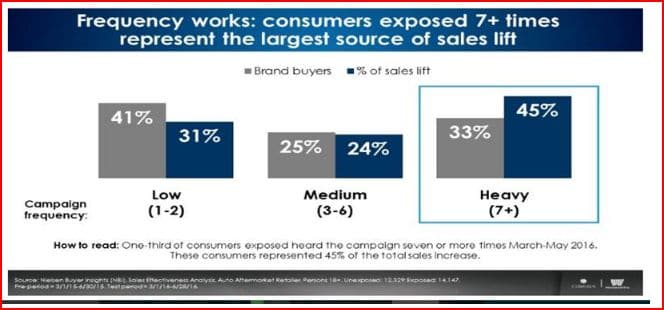
(By Bob McCurdy) Does big reach or heavy frequency produce a better ROI? It’s a question that’s been asked for decades. The answer below might surprise you.
Thanks to a recent Nielsen study overseen by Pierre Bouvard Cumulus/Westwood One’s Chief Insights Officer (the industry is lucky to have Bouvard in the field touting its story), we were able to extract some empirical insight regarding the answer to this reach/frequency question.
Overall, the study’s ROAS (return-on-ad-spend) results were spectacular, concluding that for every $1 invested in radio an auto aftermarket retailer generated $21 in sales. Outstanding!
One particular study slide caught our attention. We dug into it to see if, with a little extrapolation, we could shed any light on this reach, frequency, ROI question.
Per below, the “heavy frequency” column did generate the most sales lift but those brand buyers in the “low frequency” column generated ROI much more efficiently. The reason is simple: relevance. If a message is relevant, we’re more likely to pay attention and react. If it’s not, we won’t, no matter how many times we’re exposed to it.
The gray bars in the chart represent the percent of total brand buyers in each of the three frequency columns. For sake of example, let’s say that there were 100 total brand buyers. Regardless of the actual number, the results below are relative and wouldn’t change.
So…
- 41%, or 41, were brand buyers in the low-frequency column. These individuals were exposed to the retailer’s commercial an average of 1.5x (the average of 1 + 2)
- 25%, or 25, were brand buyers in the medium-frequency column. These individuals were exposed to the commercial an average of 4.5x (the average of 3 + 6).
- 33%, or 33, brand buyers in the heavy-frequency (7+) column. These individuals were exposed to the commercial an average of 10x. Seems like a fair figure.
“Reach” x “frequency” equals gross impressions. So let’s compute the number of gross impressions it took for each column to generate the sales increase that each produced:
Low frequency: 41 brand buyers (reach) exposed to an average of 1.5 commercials (frequency) equals 61.5 gross impressions. These 61.5 gross impressions contributed 31% of the total sales increase, which equates to 1.98 impressions required to generate a 1% increase in sales (61.5/31).
Medium frequency: 25 brand buyers (reach) exposed to an average of 4.5 commercials (frequency), equals 112.5 total gross impressions. These 112.5 gross impressions contributed 24% of the total sales increase, which equates to 4.7 impressions required to generate a 1% increase in sales (112.5/24).
Heavy frequency: 33 brand buyers (reach) exposed to an average of 10 commercials (frequency), equals 330 total gross impressions. These 330 gross impressions contributed 45% of the total sales increase, which equates to 7.3 impressions required to generate a 1% increase in sales (330/45).
Gross impression for gross impression, which is the same as saying dollar for dollar, it cost 2.4x as much to generate a 1% increase in sales in the medium-frequency column (4.7/1.98) and 3.7x (7.3/1.98) as much to generate a 1% increase in sales in the heavy-frequency column as it did in the low-frequency column.
Key takeaways:
- This study supports “recency,” which stresses “reach and don’t preach.”
- It also supports what other single-source research studies have shown, which is that an exposure or two is all that’s required to generate results. Heavy redundant frequency reduces ROI, as the 4th, 5th, 10th exposure costs the same as the first couple but the ROI from those exposures is considerably lower (above). Commercials do have a lingering effect, so any repeat exposure within a short timeframe is less efficient than reaching an entirely new potential customer.
- The optimum way to maximize ROI is to utilize multiple dayparts and stations to generate the greatest reach.
Based upon the data above, had this retailer’s campaign generated greater reach and a more balanced frequency distribution, our bet is that the $21 ROAS would have been even higher.
There are situations when heavy frequency is necessary, e.g. when a message is complex or when there’s a new product intro. But generally speaking, with “time sensitive” or “call to action” campaigns, which comprise the majority of our business, “reach” not “frequency” should be the goal.
Think of “relevance” as a substitute for “frequency.” So instead of “reach x frequency = response,” think “reach x relevance = response” and schedule your client’s commercials accordingly.
Bob McCurdy is The Vice President of Sales for The Beasley Media Group and can be reached at [email protected]






